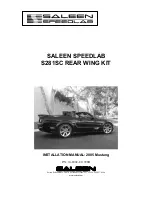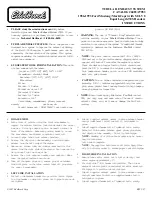
Engine General Information and Diagnosis: 1A-2
General Description
Statement on Cleanliness and Care
S3RH0B1101001
An automobile engine is a combination of many
machined, honed, polished and lapped surfaces with
tolerances that are measured in the thousands of an
millimeter (ten thousands of an inch).
Accordingly, when any internal engine parts are
serviced, care and cleanliness are important.
It should be understood that proper cleaning and
protection of machined surfaces and friction areas is part
of the repair procedure. This is considered standard
shop practice even if not specifically stated.
• A liberal coating of engine oil should be applied to
friction areas during assembly to protect and lubricate
the surfaces on initial operation.
• Whenever valve train components, pistons, piston
rings, connecting rods, rod bearings, and crankshaft
journal bearings are removed for service, they should
be retained in order.
At the time of installation, they should be installed in
the same locations and with the same mating
surfaces as when removed.
• Battery cables should be disconnected before any
major work is performed on the engine.
Failure to disconnect cables may result in damage to
wire harness or other electrical parts.
• Throughout this manual, the four cylinders of the
engine are identified by numbers; No.1 (1), No.2 (2),
No.3 (3) and No.4 (4) counted from crankshaft pulley
side to flywheel side.
Engine Diagnosis General Description
S3RH0B1101002
This vehicle is equipped with an engine and emission
control system which are under control of ECM.
The engine and emission control system in this vehicle
are controlled by ECM. ECM has an On-Board
Diagnostic system which detects a malfunction in this
system and abnormality of those parts that influence the
engine exhaust emission. When diagnosing engine
troubles, be sure to have full understanding of the outline
of “On-Board Diagnostic System Description” and each
item in “Precautions in Diagnosing Trouble” and execute
diagnosis according to “Engine and Emission Control
System Check”.
There is a close relationship between the engine
mechanical, engine cooling system, ignition system,
exhaust system, etc. and the engine and emission
control system in their structure and operation. In case of
an engine trouble, even when the malfunction indicator
lamp (MIL) doesn’t turn ON, it should be diagnosed
according to this flow table.
On-Board Diagnostic System Description
S3RH0B1101003
ECM diagnosis troubles which may occur in the area
including the following parts when the ignition switch is
ON and the engine is running, and indicates the result by
turning on or flashing malfunction indicator lamp (1).
• Heated oxygen sensor
• ECT sensor
• TP sensor
• IAT sensor
• MAP sensor
• CMP sensor
• CKP sensor
• Knock sensor (if equipped)
• VSS
• Barometric pressure sensor
• Camshaft position control
• Oil control valve (Camshaft Position Control)
• CPU (Central Processing Unit) of ECM
ECM and malfunction indicator lamp (1) operate as
follows.
• Malfunction indicator lamp (1) lights when the ignition
switch is turned ON (but the engine at stop) with the
diagnosis switch terminal ungrounded regardless of
the condition of Engine and Emission control system.
This is only to check the malfunction indicator lamp (1)
in the combination meter and its circuit.
• If the above areas of Engine and Emission control
system is free from any trouble after the engine start
(while engine is running), malfunction indicator lamp
(1) turns OFF.
• When ECM detects a trouble which has occurred in
the above areas, it makes malfunction indicator lamp
(1) turn ON while the engine is running to warn the
driver of such occurrence of trouble and at the same
time it stores the trouble area in ECM back-up
memory. (The memory is kept as it is even if the
trouble was only temporary and disappeared
immediately. And it is not erased unless the power to
ECM is shut off for specified time or it is cleared by
SUZUKI scan tool.)
ECM also indicates trouble area in memory by means
of flashing of malfunction indicator lamp (1) at the time
of inspection. (i.e. when diagnosis switch terminal (2)
is connected to ground terminal (3) with a service wire
(4) and ignition switch is turned ON.)
1
2
3
4
I2RH0B110001-01
Содержание Liana RH418
Страница 4: ......
Страница 222: ...3A 13 Drive Shaft Axle ...
Страница 362: ...5A 136 Automatic Transmission Transaxle ...
Страница 370: ...Prepared by 1st Ed Feb 2004 2nd Ed Jul 2006 367 ...
Страница 371: ...14 mm 99501 54G30 24E 99501 54G30 24E SUPPLEMENTARY SERVICE MANUAL SUPPLEMENTARY SERVICE MANUAL ...
















































